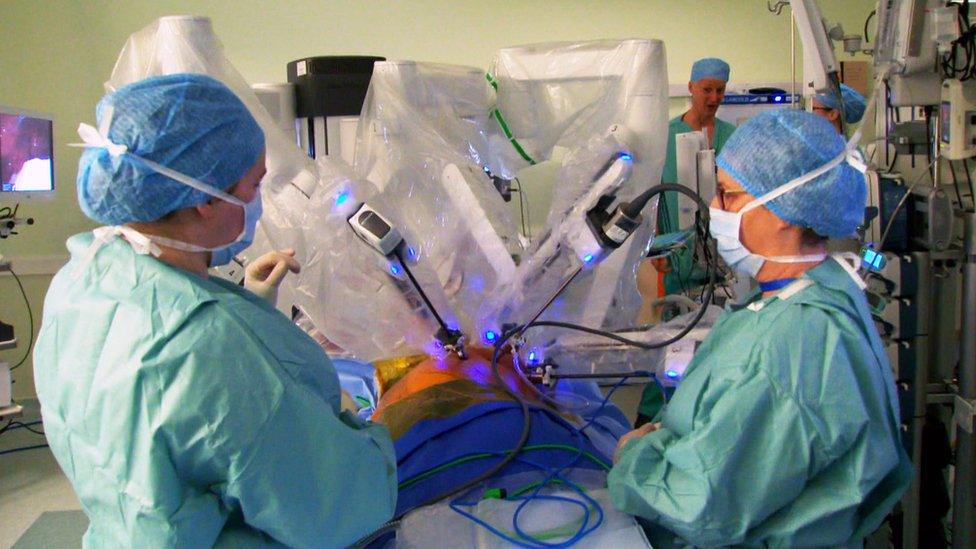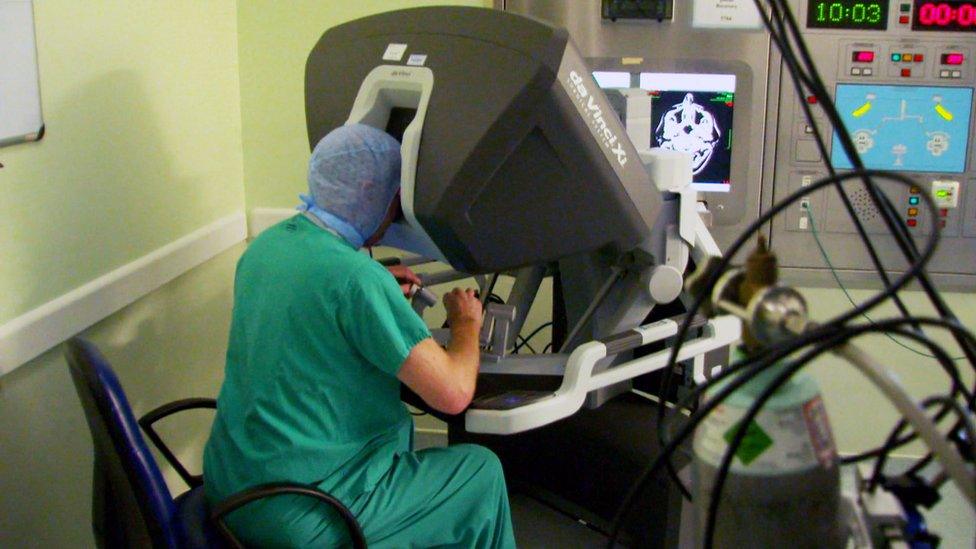The NHS robots performing major surgery
- Published

Three robotic arms replace the surgeon's hands during an operation at the Golden Jubilee Hospital
How would you feel about a robot performing major surgery on you?
2019 has seen a boom in the use of cutting edge robotic technology and there is more to come.
Evidence suggests robotic surgery can be less invasive and improve recovery time for patients.
That could be good news with ever growing demand on health services.
At the Golden Jubilee Hospital in Clydebank, I watch an operation taking place with three robotic arms operating on a patient where a surgeon's hands would normally be.
The robotic arms are seeing, feeling and manipulating with incredible precision.
In this case, they are removing the patient's thymus gland from between the lungs.
The surgical robot takes this operation a step beyond traditional keyhole surgery.

Stephen O'Reilly said he hoped it would speed up his recovery
The patient is Stephen O'Reilly, whom I spoke to 20 minutes earlier as he prepared to put his trust in robotic assisted surgery, hoping it would mean he could get back to work more quickly.
"It sounds quite interesting," he said. "The surgeon says it speeds it up. If they cut you open you could be in hospital for a week but I could be away in a day or two.
"It helps your recovery and stops them having to open you up. The last time I got surgery was in 1992 when I broke my leg. It's a lot different now."
Once he is in the operating theatre and under anaesthetic, the £2m Da Vinci robot takes over from the human team.
But control is still in the surgeon's hands - just remotely via a console.

Consultant thoracic surgeon Alan Kirk has control of the robot from a remote console
Consultant thoracic surgeon Alan Kirk went through additional training to operate in this way.
Ordinarily Mr Kirk would be hunched over the operating table for two or three hours performing a procedure like this.
It is physically and mentally demanding. The use of robotic technology can relieve some of that pressure but it takes a period of adjustment to get used to being at the controls, at some distance from the patient.
Mr Kirk said: "The selling points for robotics are improving patient outcomes by having smaller holes and incisions that are less painful.
"The vision we get is also far better than any keyhole procedures we have already, so it's 10 times magnification, 3D, high definition vision - and with the technology of the instruments with 360 degree articulation, and 7 degrees of freedom, it allows us to do things that we couldn't do even with open surgery sometimes."

Mr Kirk went through additional training to operate in this way
The American-made da Vinci robot has dominated robotic surgery in the UK for 15 years.
But as the new decade approaches, more versatile models are arriving on the market - such as the British-designed Versius robot that is coming on stream.
For more routine surgery like hip and knees - a robotic arm called Mako is helping create incredibly precise replacements based on individual anatomy.

A robotic arm called Mako is helping create incredibly precise replacements
Orthopaedic surgeon Nick Ohly said: "We can give every patient a customised or personalised knee replacement, based on their own specific anatomy and the only way to do that is with technology like this.
"We have a 3D virtual image of the anatomy, we can plan the operation virtually before we've even cut the bones and then execute it exactly as per the plans, so we know that what we do is exactly what we wanted."
Surgeons clearly believe that robotics will be a big part of their future.
But with a growing choice of technology available, it will mean careful, evidence-based decisions about what provides the best value for money, for the NHS's long-term investment.
- Published3 September 2018